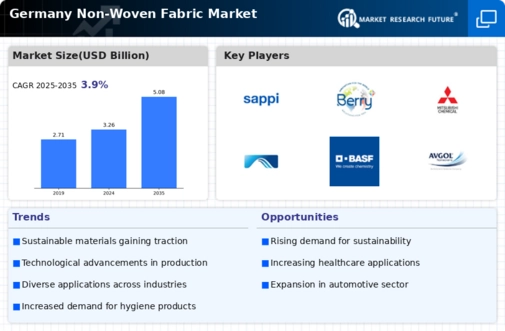The non woven fabric market in Germany is characterized by a dynamic competitive landscape, driven by innovation, sustainability, and strategic partnerships. Key players such as Freudenberg (DE), BASF (DE), and Ahlstrom-Munksjo (FI) are actively shaping the market through their distinct operational focuses. Freudenberg (DE) emphasizes innovation in product development, particularly in the automotive and hygiene sectors, while BASF (DE) leverages its extensive chemical expertise to enhance the performance characteristics of non woven materials. Ahlstrom-Munksjo (FI) appears to be concentrating on sustainability, aiming to provide eco-friendly solutions that meet the growing demand for environmentally responsible products. Collectively, these strategies contribute to a competitive environment that is increasingly focused on technological advancement and sustainability.
In terms of business tactics, companies are localizing manufacturing to reduce lead times and optimize supply chains. The market structure is moderately fragmented, with several key players exerting influence over various segments. This fragmentation allows for niche players to thrive, while larger companies leverage economies of scale to maintain competitive pricing. The collective influence of these key players fosters a competitive atmosphere where innovation and operational efficiency are paramount.
In November 2025, Freudenberg (DE) announced the launch of a new line of biodegradable non woven fabrics aimed at the hygiene market. This strategic move not only aligns with the increasing consumer demand for sustainable products but also positions Freudenberg (DE) as a leader in eco-friendly innovations within the sector. The introduction of biodegradable options could potentially enhance their market share and appeal to environmentally conscious consumers.
In October 2025, BASF (DE) unveiled a partnership with a leading automotive manufacturer to develop advanced non woven materials that improve vehicle lightweighting and fuel efficiency. This collaboration underscores BASF's (DE) commitment to innovation and its strategic focus on the automotive sector, which is increasingly prioritizing sustainability. The partnership is likely to enhance BASF's (DE) competitive edge by integrating cutting-edge technology into their product offerings.
In September 2025, Ahlstrom-Munksjo (FI) expanded its production capacity in Germany to meet the rising demand for medical non woven fabrics. This expansion reflects Ahlstrom-Munksjo's (FI) strategic intent to capitalize on the growing healthcare sector, particularly in the context of increased hygiene awareness. By enhancing production capabilities, the company is well-positioned to respond to market needs and strengthen its foothold in the medical segment.
As of December 2025, current competitive trends indicate a pronounced shift towards digitalization, sustainability, and the integration of AI technologies in production processes. Strategic alliances are increasingly shaping the landscape, enabling companies to pool resources and expertise to drive innovation. The competitive differentiation is likely to evolve from traditional price-based competition to a focus on technological advancements, supply chain reliability, and sustainable practices. This shift suggests that companies that prioritize innovation and sustainability will be better positioned to thrive in the future.





















Leave a Comment